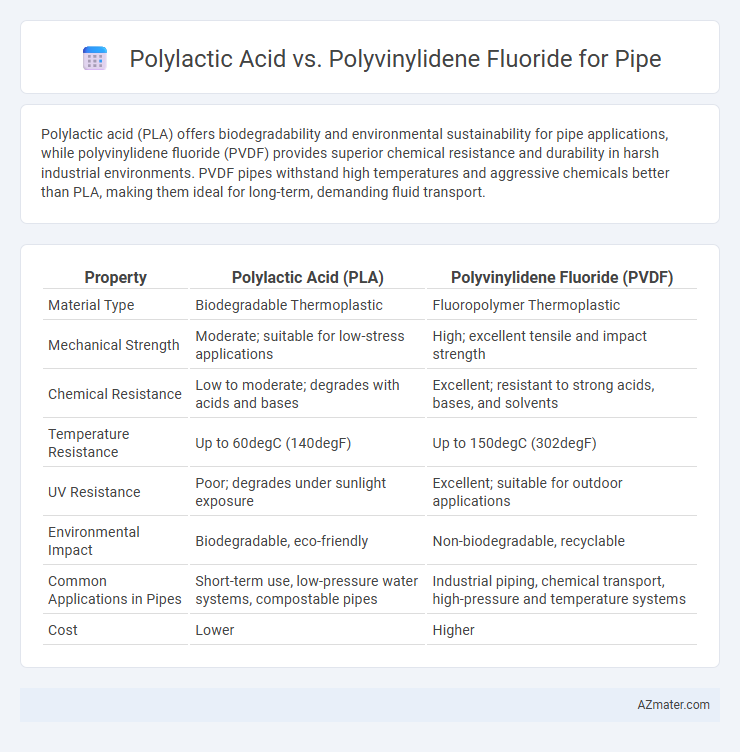Polylactic acid (PLA) offers biodegradability and environmental sustainability for pipe applications, while polyvinylidene fluoride (PVDF) provides superior chemical resistance and durability in harsh industrial environments. PVDF pipes withstand high temperatures and aggressive chemicals better than PLA, making them ideal for long-term, demanding fluid transport.
Table of Comparison
| Property | Polylactic Acid (PLA) | Polyvinylidene Fluoride (PVDF) |
|---|---|---|
| Material Type | Biodegradable Thermoplastic | Fluoropolymer Thermoplastic |
| Mechanical Strength | Moderate; suitable for low-stress applications | High; excellent tensile and impact strength |
| Chemical Resistance | Low to moderate; degrades with acids and bases | Excellent; resistant to strong acids, bases, and solvents |
| Temperature Resistance | Up to 60degC (140degF) | Up to 150degC (302degF) |
| UV Resistance | Poor; degrades under sunlight exposure | Excellent; suitable for outdoor applications |
| Environmental Impact | Biodegradable, eco-friendly | Non-biodegradable, recyclable |
| Common Applications in Pipes | Short-term use, low-pressure water systems, compostable pipes | Industrial piping, chemical transport, high-pressure and temperature systems |
| Cost | Lower | Higher |
Introduction to Polylactic Acid (PLA) and Polyvinylidene Fluoride (PVDF)
Polylactic Acid (PLA) is a biodegradable thermoplastic derived from renewable resources like corn starch, offering eco-friendly alternatives in pipe applications where sustainability is crucial. Polyvinylidene Fluoride (PVDF) is a highly non-reactive and pure thermoplastic fluoropolymer known for its exceptional chemical resistance, mechanical strength, and thermal stability, making it ideal for demanding industrial pipe systems. Both materials serve distinct purposes: PLA emphasizes environmental benefits and biodegradability, while PVDF focuses on durability and high-performance in aggressive chemical environments.
Chemical Structure and Material Composition
Polylactic acid (PLA) is a biodegradable polyester derived from renewable resources such as corn starch, characterized by its ester linkages formed from lactic acid monomers. Polyvinylidene fluoride (PVDF), a semi-crystalline fluoropolymer, consists of repeating vinylidene fluoride units with strong carbon-fluorine bonds, providing exceptional chemical resistance and thermal stability. The distinct chemical structures of PLA and PVDF influence their material performance in pipes, with PLA offering biodegradability and PVDF delivering superior chemical inertness and durability.
Mechanical Strength and Durability Comparison
Polylactic acid (PLA) exhibits lower mechanical strength and durability compared to polyvinylidene fluoride (PVDF) when used in pipe applications, with PVDF demonstrating superior tensile strength, impact resistance, and chemical stability. PVDF pipes withstand higher pressures and harsh environmental conditions due to their superior abrasion resistance and thermal stability, making them ideal for industrial and chemical transport systems. In contrast, PLA pipes, being biodegradable, are more susceptible to hydrolytic degradation and mechanical wear, limiting their use primarily to low-pressure, non-corrosive environments.
Corrosion and Chemical Resistance
Polylactic acid (PLA) exhibits moderate chemical resistance but tends to degrade under acidic or alkaline environments, limiting its use in corrosive conditions for pipe applications. Polyvinylidene fluoride (PVDF) offers superior chemical and corrosion resistance, maintaining integrity against a wide range of aggressive chemicals, including acids, bases, and solvents. PVDF's exceptional durability under harsh chemical exposure makes it a preferred choice over PLA for pipes requiring long-term corrosion resistance.
Temperature and Thermal Stability
Polylactic acid (PLA) exhibits a lower thermal stability with a maximum service temperature around 60degC, making it less suitable for high-temperature pipe applications. Polyvinylidene fluoride (PVDF) demonstrates superior thermal resistance, maintaining stability and mechanical integrity at temperatures up to 150degC. This significant difference in thermal performance positions PVDF as the preferred material for pipes requiring high temperature and thermal stability.
Environmental Impact and Sustainability
Polylactic acid (PLA) offers a significant environmental advantage over polyvinylidene fluoride (PVDF) pipes due to its biodegradability and production from renewable resources like corn starch or sugarcane, reducing carbon footprint and reliance on fossil fuels. PVDF pipes, while highly durable and chemically resistant, are derived from non-renewable petroleum-based sources and pose challenges in recycling and degradation, leading to long-term environmental persistence. Choosing PLA pipes supports a circular economy by minimizing plastic waste and promoting sustainability in infrastructure projects.
Cost Analysis and Economic Considerations
Polylactic acid (PLA) pipes typically offer a lower initial cost compared to polyvinylidene fluoride (PVDF) pipes, primarily due to the renewable nature of PLA and simpler manufacturing processes. PVDF pipes, while more expensive upfront, provide superior chemical resistance and durability, potentially reducing long-term maintenance and replacement expenses. Economic considerations must balance PLA's cost-effectiveness for short-term applications against PVDF's higher investment that yields extended service life and reduced operational costs.
Application Suitability in Piping Systems
Polylactic acid (PLA) offers biodegradability and is suitable for low-pressure, short-term piping applications such as irrigation and temporary fluid transport, primarily in environmentally conscious projects. Polyvinylidene fluoride (PVDF) excels in chemical resistance, mechanical strength, and temperature tolerance, making it ideal for industrial piping systems handling aggressive chemicals, high pressure, and high-temperature fluids. The choice between PLA and PVDF depends largely on the specific application requirements, including chemical exposure, temperature range, and environmental impact considerations.
Installation, Maintenance, and Longevity
Polylactic acid (PLA) pipes offer easier installation due to their lightweight and biodegradable nature, though they require careful handling to prevent damage from UV exposure and moisture during setup. Polyvinylidene fluoride (PVDF) pipes provide superior chemical resistance and durability, resulting in lower maintenance requirements and longer service life in harsh environments. PVDF's high thermal stability and resistance to abrasion make it a preferred choice for applications demanding long-term reliability and minimal upkeep.
Conclusion: Choosing Between PLA and PVDF for Pipes
Polylactic acid (PLA) offers biodegradability and environmental benefits, making it suitable for temporary or low-pressure piping applications where sustainability is prioritized. Polyvinylidene fluoride (PVDF) excels in chemical resistance, mechanical strength, and temperature tolerance, ideal for industrial pipes requiring durability and corrosion resistance. Selecting between PLA and PVDF for pipes depends on application demands: choose PLA for eco-friendly, short-term use and PVDF for long-term, high-performance systems.

Infographic: Polylactic acid vs Polyvinylidene fluoride for Pipe
 azmater.com
azmater.com